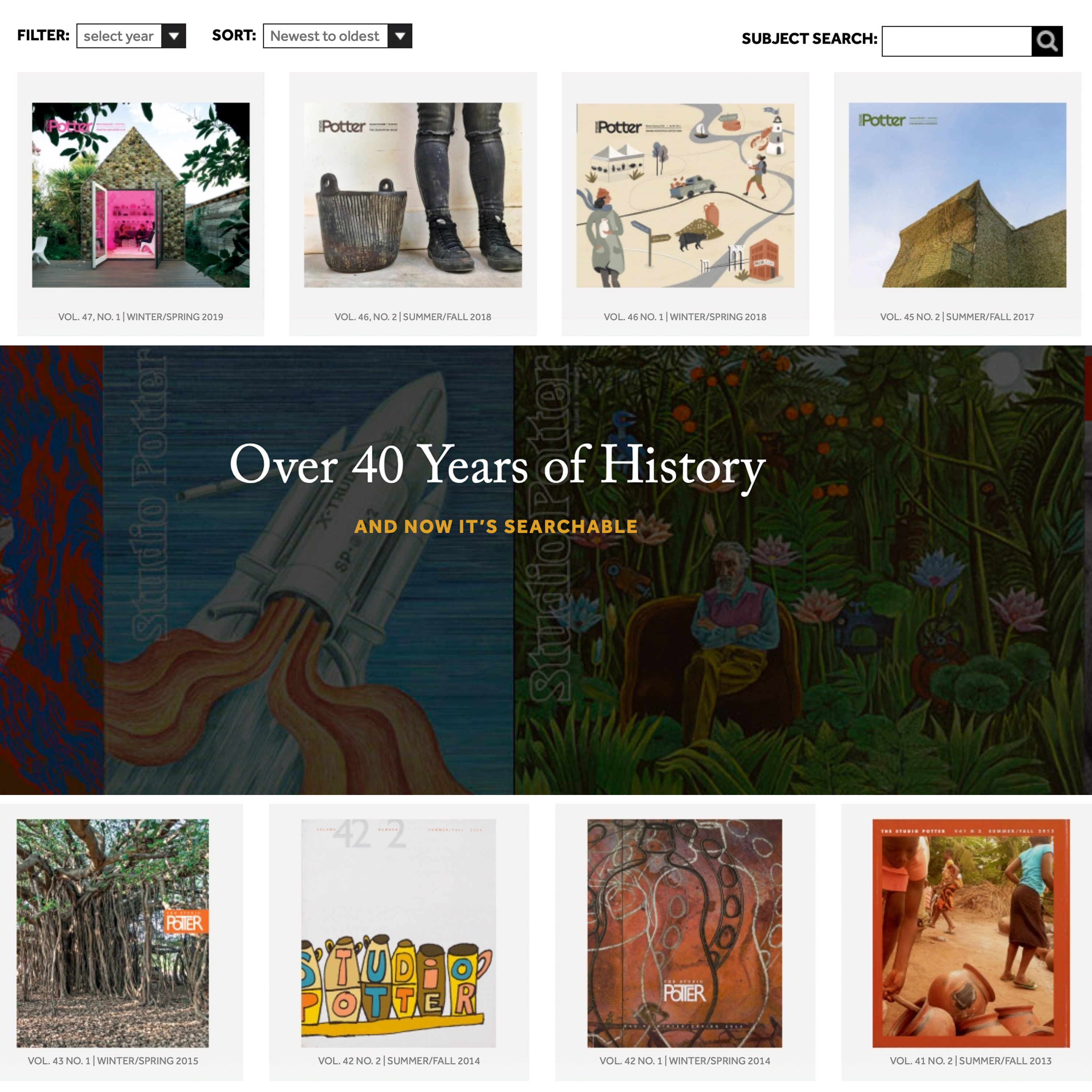
We'd like to offer some suggestions for how to use Studio Potter as an educational resource.
To use Studio Potter's archive of ceramic articles as a resource, click the search option on our site. That will allow you and your students to search for a topic, artist, region, or technique. The archive contains every issue of Studio Potter ever printed. That’s over 40 years of history.
You can frame a question for your students and send them to our site to unearth what professionals in the field have contributed on the topic since 1972. Also, remember that the printed journals are already organized by theme. To that end, it is pretty easy to use one journal as a topic parameter. The last point we would like to draw your attention to today is that, when you link to our site and read the offer for the three month free access to the archive, there is an assignment embedded in the offer. You can assign your students the task of writing an article for Studio Potter. You, as the instructor, pick the top three and submit them to editor@studiopotter.org to be considered for future publication on the site. The student authors selected will receive a one-year membership to Studio Potter.
To get you jumpstarted on the search engine, why not form a question-making exercise with your students? How many thesis questions can your class create that would set them on a road to research within the Studio Potter archive? Such brainstorming is a great critical thinking exercise. They don’t even have to consider what the Studio Potter archive holds to create questions.
However, we’ll also put forth a few options here to get your brains rolling in the right direction. Some topics pulled from the survey we are running to gauge audience interest have included:
How has technology evolved in contemporary ceramics and what are the positive and negative implications? What do you think will be the financial and/or aesthetic implications on the future of contemporary craft?
A search of the word “Technology” pulls up 17 pages of articles and volumes on our site.
“Towards an Aesthetic of Digital Clay”
“Richard Burkett on Computers: Then and Now”
“Craft's New Tomorrow: A Case For Technology In Craft-Based Education”
Sustainability. We just ran an article by Robert Harrison, but the topic is an ongoing concern in our field. Have your students research what professionals have had to say about the topic and then encourage them to interview actual professionals who are clearly working toward sustainability and those who are bringing in materials that might raise an eyebrow. In particular, I’m thinking of work that uses resin and solvents. How are people factoring in, if they are at all, their carbon footprint in the creative process? Maybe you can even have your students take a look at the processes in place in your own department. Have them use the Studio Potter archive, artist interviews, and your institutional guidelines. Have them bottom-line the price point too. It could turn into a great economic exercise and create an opportunity to have them think about the cost of creating their own studio.
Politics of being a craftsperson in the 21st century and beyond. The hashtag #potteryispolitical is another ongoing conversation and in our survey comments were polarized on the matter. “Leave it out altogether,” rang out in equal measure with, “Give more time to the politics at play in the field.” What does it mean to be political as a maker? Is the act of choosing the life of a maker a political act, even if your goal is to make a really good useful object? Does a maker have a responsibility to use surface and form to carry a more blatant message? Again, the archive and artist interviews can work together, plus you can add in the history of art beyond the field of ceramics. Have them look at the works of Honore Daumier, William Hogarth, Frida Kahlo, Thomas Nast, or just tell them they have to find three examples outside of ceramics as well as examples within ceramics. The Studio Potter archive is just one piece of the puzzle.
Finally, assign them three random articles. Metaphorically, throw a dart at the wall. One parameter though, tell your students to choose from articles that are at least five years old. From the three articles, ask them to choose one and then continue the conversation by finding out how it has evolved. Ask them to respond to the topic from their lens. Your students don’t know all the “rules” yet. Your students have unencumbered vision and might find new paths for all of us to consider.
We hope by adding these seeds to your brainstorming the coming days will be fruitful for you and your students.
Be well,
Studio Potter
Update: We also published this article, "Lesson Plans and Resources for Remote Teaching", in March 2020.
